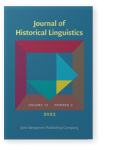Vol. 12:2 (2022) ► pp.194–240
Asyndetic complementation and referential integration in Spanish
A diachronic probabilistic grammar account
This paper examines a distinctive syntactic feature of (pre)classical Spanish: asyndetic complementation (without complementizer que ‘that’). While many authors regard this construction as a stylistic variant which eventually declined (i.a., Girón 2005), so far no exhaustive morphosyntactic study of the phenomenon has been presented, as previous works either have focused on only one predicate (Blas Arroyo & Porcar Miralles 2016, 2018) or do not contain detailed quantitative data (Pountain 2015). Using evidence from richly annotated corpus data spanning between 1400 and 1799 (GITHE 2015), we adopt the diachronic probabilistic grammar framework (Szmrecsanyi 2013) by means of multifactorial statistical models, to identify the language-internal probabilistic constraints that regulated the que/Ø alternation, and to explore whether their relevance changed diachronically. The results indicate that asyndetic complementation is promoted in the domain of manipulation verbs (e.g., requests and commands) and, more generally, by the semantic and syntactic integration of events (Givón 2001a). Diachronically we observe that some of the effects strengthened over time, suggesting a syntactic specialization process, which might have eventually led to the restricted and marked use of the asyndeton in Modern Spanish.
Article outline
- 1.Introduction
- 2.Asyndetic complementation in historical Spanish: The state of the art
- 3.Hypothesis
- 4.Data and methodology
- 4.1The data
- 4.2An analytical approach to syntactic variation
- 5.Predictor variables
- 6.Results
- 6.1Asyndetic complementation in a diachronic perspective
- 6.2Panchronic model
- 6.3Diachronic model
- 7.Discussion
- 7.1The role of referential integration
- 7.2The role of impersonal constructions
- 8.Conclusion
- Acknowledgements
- Notes
- Abbreviations
-
References
